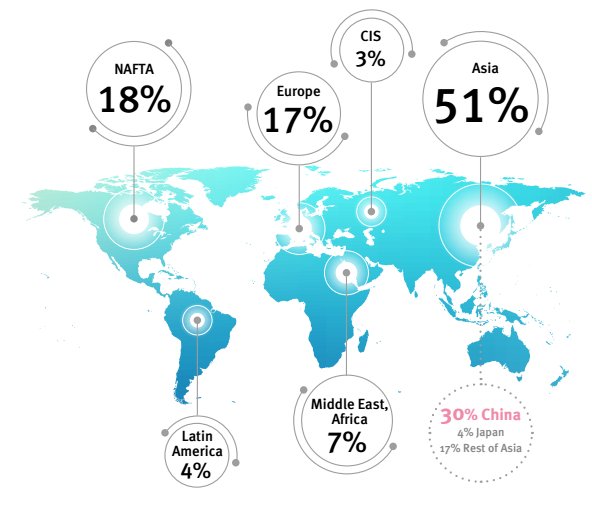Plastics—the Facts is an analysis of the data related to the production, demand, and waste management of plastic materials. It provides the latest business information on production and demand, trade, recovery as well as employment and turnover in the plastics industry. In short, this report gives an insight into the industry’s contribution to European economic growth and prosperity throughout the life cycle of the material. The data presented in this report was collected by PlasticsEurope (the Association of Plastics Manufacturers in Europe) and EPRO (the European Association of Plastics Recycling and Recovery Organisations). PlasticsEurope’s Market Research and Statistics Group (PEMRG) provided input on the production and the demand for plastic raw materials. Conversion Market & Strategy GmbH helped assess the waste collection and recovery data. Official statistics from European or national authorities and waste management organizations have been used for recovery and trade data, where available. Research or expertise from consultants completed gaps. Figures cannot always be directly compared with those of previous years due to changes in estimates. Some estimates from previous years have been revised in order to track progress, e.g. for use and recovery of plastics across Europe over the past decade.
All figures and graphs in this report show data for EU-28 plus Norway and Switzerland, which is referred to as Europe for the purposes of abbreviation –other country groups are explicitly listed. The European plastics industry supports the European Commission's strategy for Plastics in a Circular Economy and is highly committed to accelerating its transformation towards an even more circular and resource-efficient plastic economy. Since the very beginning, plastic materials were born as a solution for the substitution of scarce and non-sustainable resources such as tortoiseshell, ivory, or animal bones. Since then, plastics have shaped the world bringing safety, hygiene, comfort, and wellbeing to our society. Today resource-efficient plastics are present in an infinite range of products and applications helping us to save energy, CO2 emissions, water, and even food. They contribute to circularity, to health and safety, and to mitigate climate change. Without a doubt, plastics have shaped our lives and will shape the future.
However, to make the most of these extraordinary materials, challenges related to the end of life of certain products - and particularly plastic packaging – still need to be addressed. PlasticsEurope’s “Plastics 2030” Voluntary Commitment has taken the industry to the next level of engagement by establishing ambitious targets and initiatives to prevent the leakage of plastics into the environment; increasing the reuse and recycling of plastic packaging waste and contributing to resource efficiency benefits.
Marine litter is a global challenge and it is unacceptable that waste, including plastic waste, ends up in our environment, our rivers, and our oceans. Plastics are valuable resources that bring numerous benefits to society by offering sustainable solutions in countless sectors. Whether caused by irresponsible behavior or poor waste management practices, it is deplorable that plastics are littered.
For years, the plastics industry has been engaged at a global level in combatting marine litter. PlasticsEurope is a committed signatory to the global Declaration for Marine Litter Solutions for preventing leakage of plastics into the environment. In the framework of the Global Plastics Alliance (an alliance of 74 plastics associations from around the world) over 355 projects have been run or are ongoing in different parts of the globe to fight this problem.
PlasticsEurope is also committed to preventing pellet loss and is a signatory of the initiative Operation Clean Sweep©, a voluntary program that promotes proper pellets containment along the entire plastics value chain. This program is being implemented across the plastics industry value chain in order to avoid plastic pellet spills. We talk about "Plastics" as if it were a single material, but that is not the case.
In the same way that we know that there are different types of metals with different properties, plastics are also an extended family of different materials. Each plastic is designed with specific characteristics that make it ideal for the application to which it is intended, providing us with very resource-efficient solutions. Plastic materials can be produced from different sources. Its raw materials can be of fossil origin (crude oil, gas, etc) or renewable (sugar cane, starch, vegetable oils, etc), or even mineral base (salt). Regardless of the nature of their raw materials, certain plastics are also biodegradable. This means that provided they are properly collected and treated together with organic waste, they can biodegrade and become compost.
Whatever their origin, at the end of their service life, plastic materials are important resources that we can use either in the form of new materials or as an alternative energy source once used in energy recovery facilities.
The two categories of plastics
1. Thermoplastics
Thermoplastics are a family of plastics that can be melted when heated and hardened when cooled. These characteristics, which lend the material its name, are reversible. That is, it can be reheated, reshaped, and frozen repeatedly.
- Polyethylene (PE)
- Polypropylene (PP)
- Polyvinyl-chloride (PVC)
- Polyethylene Terephthalate (PET)
- Polystyrene (PS)
- Expanded polystyrene (EPS)
- ABS
- SAN
- Polyamides (PA)
- Polycarbonate (PC)
- Polymethyl methacrylate (PMMA)
- Thermoplastic elastomers (TPE)
- Polyarylsulfone (PSU)
- Fluoropolymers
- PEEK
- POM
- PBT
- EVOH
- Etc.
2. Thermosets
Thermosets are a family of plastics that undergo a chemical change when heated, creating a three-dimensional network. After they are heated and formed these plastics cannot be re-melted and reformed.
- Polyurethane (PUR)
- Unsaturated polyesters
- Epoxy resins
- Melamine resin
- Vinyl esters
- Silicone
- Phenol - formaldehyde resins
- Urea-formaldehyde resins
- Phenolic resins
- Acrylic resins
- Etc.
SOURCE: PlasticsEurope Market Research Group (PEMRG) and Conversio Market & Strategy GmbH.



















